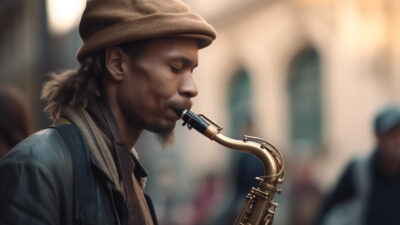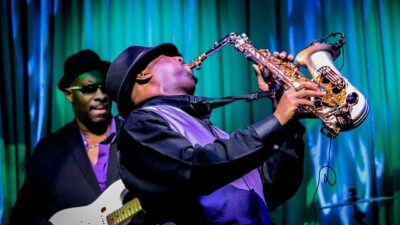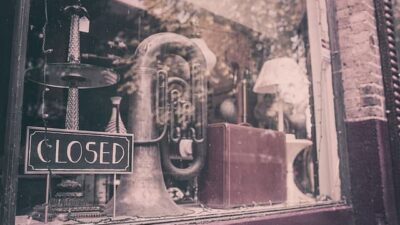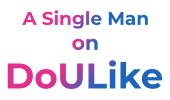Historically it was the cornet, the brass musical instrument, that was most typical and basic for jazz, but over the centuries of evolution other instruments have become part of the permanent jazz arsenal. These include the piano, drums, double bass, and, after the invention of Adolph Sax, the saxophone. Violin, clarinet and other types of percussion may often be added. Some of these can have a unique sound and are used quite often in the jazz mainstream. This approach to music demonstrates a fresh and unusual take on the style and character of playing.
The following list includes musicians who played mostly or almost single-handedly on rare jazz instruments. It does not include those performers who used rare and unusual instruments for jazz partially, that is, only to create effects and to add originality to the sound in a particular composition.
Bagpipes
The most unusual instrument for jazz can be considered a bagpipe, a cloth bag with air and tongues, whose size and shape may vary depending on the geographical location. The most commonly used nowadays is the so-called “Scottish bagpipe,” and if a jazz musician decides to play bagpipes, he chooses that type of instrument. The story of Rufus Harley’s acquaintance with the instrument is quite unusual. The musician left the tenor saxophone after he was fascinated by the bagpipe playing at the funeral of John Kennedy. Harley recorded several albums on the Atlantic Records label, but perhaps his truly unique work was released in 1972, a recording from a live concert of Re-creation of the Gods on the Transparency label. The record was recorded strictly in the tradition of soul jazz with a fair amount of spirituality and groove, thanks to Bill Mason. Rufus Hurley’s unrestrained bagpipe playing is reminiscent of Rahsaan Roland Kirk playing manzello and saxophone at the same time.
Ukulele
Another musical instrument that is quite rare in jazz is the ukulele, a four-stringed plucked lute. It was first played in Portugal and Hawaii. The ukulele has not many supporters as an instrument, especially not anyone who plays it better than Lyle Ritz. Having first chosen the tuba and the double bass, in the mid-1950s Ritz appreciated all the advantages of this unusual instrument and immediately switched to it. His first record, How About Uke? remains a jazz masterpiece. On the Verve label in 1957. In Ritz’s hands, the ukulele sounds soft and gentle, carving elegant and supple lines that harmonize remarkably with the masculine playing style of flutist Don Shelton.
Harp
The harp, the musical instrument of angels, has a rich history in classical Western and Eastern culture, but its use in jazz was little more than a gimmick until Dorothy Ashby came along. Trained as a professional pianist, Ashby turned her attention to the harp almost early in her career. She recorded some delightful bop-oriented albums in the 1950s and ’60s. Her major album Afro-Harping was recorded a little later, in 1968, on the Cadet label. Her unique sound and ingenious approach to playing this “fabulous” instrument can be seen throughout the album’s tracks. Her intricate phrases glide in and out simultaneously to the funky groove of arranger and orchestra conductor Richard Evans.
Accordion
This instrument no longer seems unusual for modern jazz, but instead fits perfectly into the romantic culture of France. Being associated mostly with Argentinean tango or European folk, accordion has still managed to take its place among jazz instruments thanks to Richard Galliano. Breaking these stereotypes, the Frenchman was the first to perform brilliant improvisations on it. His best record was French Touch in 1998 on the Dreyfus label. Inviting only a drummer and a double bassist, Galliano demonstrated his improvisation and virtuosity, proving his right to include the accordion in the list of jazz instruments.
Bassoon
Of all the double-tongued instruments, the bassoon is the most likely to appear in a jazz ensemble. Despite the fact that this unusual instrument for jazz is a product of Western culture, virtuoso players on it can be counted on the fingers. The most accomplished and creatively prolific of all is Michael Rabinowitz. As an orchestrator with the Mingus Band, he recorded half a dozen great albums, but Gabrielle’s Balloon from 1977 on Jazz Focus remains the undisputed masterpiece among his other works. Rabinauitz performs solo on the brass part and demonstrates a remarkable dexterity of playing, drawing sinuous lines of melody around a dynamic rhythm section.
Euphonium
A wind instrument that remains underappreciated and often excluded from jazz ensemble is the euphonium. It can be called a cousin of the baritone trumpet, but its sound is fuller and thicker. The first musician to play the euphonium was Kiane Zawadi, or Bernard McKinney. Unfortunately, only one studio recording of Zawadi with baritone saxophonist Pepper Adams has survived, The Cool Sound Of Pepper Adams on the Savoy label, recorded in 1957. Two trumpets, both playing in a low register, echo in the melody, making the sound somber. With pianist Hank Jones, his brother drummer Elvin Jones, and double bassist George Duvivier, the quartet recorded an inspiring and compelling record that has stood the test of time.
Normaphone
A relatively new musical instrument in the wind band, the normophone was quickly forgotten. Shaped like a saxophone, with a trumpet mouthpiece and tenor saxophone valves, the normophone sounds similar to the bass trumpet or trombone.
William “Hicky” Kelley is considered the only performer on the alto-normophone as a jazz instrument. A trained euphonist, Kelley played the normophone with Curtis Peagler’s ensemble The Modern Jazz Disciples. With them on the Prestige label in 1959-60, Kelly recorded The Modern Jazz Disciples and Right Down Front, reissued in 2012 by the Spanish label Fresh Sound.
William “Hickey” Kelly’s solos are malleable, sounding clean and reminiscent of an alto trumpet, only more melodic. Although this music cannot be called absolutely groundbreaking, it still inspires experimentation in jazz.














